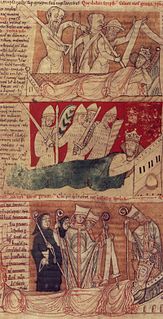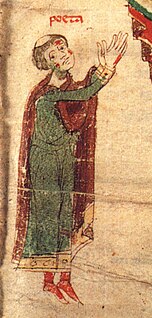 W
WCosmas of Prague was a priest, writer and historian born in a noble family in Bohemia. Between 1075 and 1081, he studied in Liège. After his return to Bohemia, he became a priest and married Božetěcha, with whom he probably had a son. In 1086, Cosmas was appointed prebendary (canonicus) of Prague, a prestigious position. As prebendary he also travelled through Europe on official matters.
 W
WPeter the Deacon was the librarian of the abbey of Montecassino and continuator of the Chronicon monasterii Casinensis, usually called the Monte Cassino Chronicle in English. The chronicle was originally written by Leo of Ostia. According to both Chalandon and Lord Norwich, Peter is a poor historian and writer, much inferior to Leo.
 W
WRalph de Diceto was archdeacon of Middlesex, dean of St Paul's Cathedral, and author of two chronicles, the Abbreviationes chronicorum and the Ymagines historiarum.
 W
WDominic of Evesham was a medieval prior of Evesham Abbey in England and historical chronicler.
 W
WEadmer or Edmer was an English historian, theologian, and ecclesiastic. He is known for being a contemporary biographer of his archbishop and companion, Saint Anselm, in his Vita Anselmi, and for his Historia novorum in Anglia, which presents the public face of Anselm. Eadmer's history is written to support the primacy of Canterbury over York, a central concern for Anselm.
 W
WEkkehard of Aura was the Abbot of Aura from 1108. A Benedictine monk and chronicler, he made updates to the World Chronicle of Frutolf of Michelsberg adding important German history between 1098 and 1125 during the reign of Emperor Henry V, in which he sided strongly with the papacy in the Investiture Controversy. He was a participant in the Crusade of 1101, and provided important source material for the Rhineland massacres of Jews and for the First Crusade.
 W
WEustathius of Thessalonica was a Byzantine Greek scholar and Archbishop of Thessalonica. He is most noted for his contemporary account of the sack of Thessalonica by the Normans in 1185, for his orations and for his commentaries on Homer, which incorporate many remarks by much earlier researchers.
 W
WGalbert of Bruges was a Flemish cleric and chronicler. A resident of Bruges and a functionary in the administration of the count of Flanders, he is known for his day-by-day Latin account De multro, traditione et occisione gloriosi Karoli comitis Flandriarum of the events surrounding the murder of Count Charles the Good, in 1127 and its aftermath up through the accession of Thierry of Alsace in summer 1128.
 W
WGallus Anonymus is the name traditionally given to the anonymous author of Gesta principum Polonorum, composed in Latin about 1115. Gallus is generally regarded as the first historian to have described Polish history. His Chronicles are an obligatory text for university courses in Poland's history. Very little is known of the author himself.
 W
WGregory of Catino was a monk of the Abbey of Farfa and "one of the most accomplished monastic historians of his age." Gregory died shortly after 1130, possibly in 1133.
 W
WHelmold of Bosau was a Saxon historian of the 12th century and a priest at Bosau near Plön. He was a friend of the two bishops of Oldenburg in Holstein, Vicelinus and Gerold, who did much to Christianize the Polabian Slavs.
 W
WJohn of Worcester was an English monk and chronicler who worked at Worcester Priory. He is usually held to be the author of the Chronicon ex chronicis.
 W
WLeo Marsicanus or Ostiensis, also known as Leone dei Conti di Marsi, was a nobleman and monk of Monte Cassino around 1061 and Italian cardinal from the 12th century.
 W
WLiber Floridus is a medieval encyclopedia that was compiled between 1090 and 1120 by Lambert, Canon of Saint-Omer. The text compiles extracts from some 192 or so different works.
 W
WLupus Protospatharius Barensis was the reputed author of the Chronicon rerum in regno Neapolitano gestarum, a concise history of the Mezzogiorno from 805 to 1102. He has only been named as the author since the seventeenth century. Lupus, along with two other Bariot chronicles, the Annales barenses and the Anonymi Barensis Chronicon, used some lost ancient annals of Bari up to 1051. William of Apulia appears to have used these same annals. Lupus also used the lost annals of Matera. Perhaps most unusual to Lupus is his dating method. He began his years in September and so places events of the latter half of a given year in the next year.
 W
WConstantine Manasses was a Byzantine chronicler who flourished in the 12th century during the reign of Manuel I Komnenos (1143-1180). He was the author of a chronicle or historical synopsis of events from the creation of the world to the end of the reign of Nikephoros Botaneiates (1081), sponsored by Irene Komnene, the emperor's sister-in-law. It consists of about 7000 lines in political verse. It obtained great popularity and appeared in a free prose translation; it was also translated into Bulgarian in the 14th century.
 W
WSaint Nestor the Chronicler was the reputed author of the Primary Chronicle Life of the Venerable Theodosius of the Kiev Caves, and Account about the Life and Martyrdom of the Blessed Passion Bearers Boris and Gleb.
 W
WOrderic Vitalis was an English chronicler and Benedictine monk who wrote one of the great contemporary chronicles of 11th- and 12th-century Normandy and Anglo-Norman England. Modern historians view him as a reliable source.
 W
WOtto of Freising was a German churchman and chronicler. He was Otto I Bishop of Freising as from 1138.
 W
WPelagius of Oviedo was a medieval ecclesiastic, historian, and forger who served the Diocese of Oviedo as an auxiliary bishop from 1098 and as bishop from 1102 until his deposition in 1130 and again from 1142 to 1143. He was an active and independent-minded prelate, who zealously defended the privileges and prestige of his diocese. During his episcopal tenure he oversaw the most productive scriptorium in Spain, which produced the vast Corpus Pelagianum, to which Pelagius contributed his own Chronicon regum Legionensium. His work as a historian is generally reliable, but for the forged, interpolated, and otherwise skillfully altered documents that emanated from his office he has been called el Fabulador and the "prince of falsifiers". It has been suggested that a monument be built in his honour in Oviedo.
 W
WPeter of Eboli or Petrus de Ebulo was a didactic versifier and chronicler who wrote in Latin.
 W
WSigebert of Gembloux was a medieval author, known mainly as a pro-Imperial historian of a universal chronicle, opposed to the expansive papacy of Gregory VII and Pascal II. Early in his life he became a monk in the Benedictine abbey of Gembloux.
 W
WSuger was a French abbot, statesman, and historian. He was one of the earliest patrons of Gothic architecture, and is widely credited with popularizing the style.
 W
WRobert of Torigni (c.1110–1186) was a Norman monk, prior, abbot and twelfth century chronicler.
 W
WÁed Ua Crimthainn, also called Áed mac Crimthainn, was abbot and coarb of Terryglass, near Lough Derg in County Tipperary, Ireland. He was the principal scribe of the Book of Leinster, the Book of Oughaval, an important Middle Irish medieval illuminated manuscript, and is also believed to have been its sole compiler.
 W
WWilliam of Newburgh or Newbury, also known as William Parvus, was a 12th-century English historian and Augustinian canon of Anglo-Saxon descent from Bridlington, East Riding of Yorkshire.
 W
WWilliam of Tyre was a medieval prelate and chronicler. As archbishop of Tyre, he is sometimes known as William II to distinguish him from his predecessor, William I, the Englishman, a former Prior of the Church of the Holy Sepulchre, who was Archbishop of Tyre from 1127 to 1135. He grew up in Jerusalem at the height of the Kingdom of Jerusalem, which had been established in 1099 after the First Crusade, and he spent twenty years studying the liberal arts and canon law in the universities of Europe.